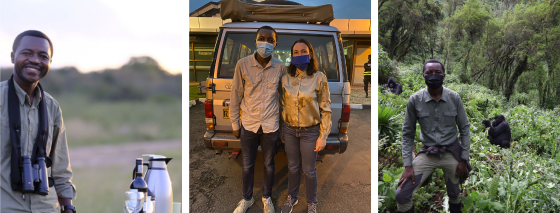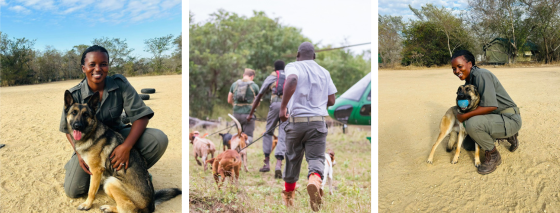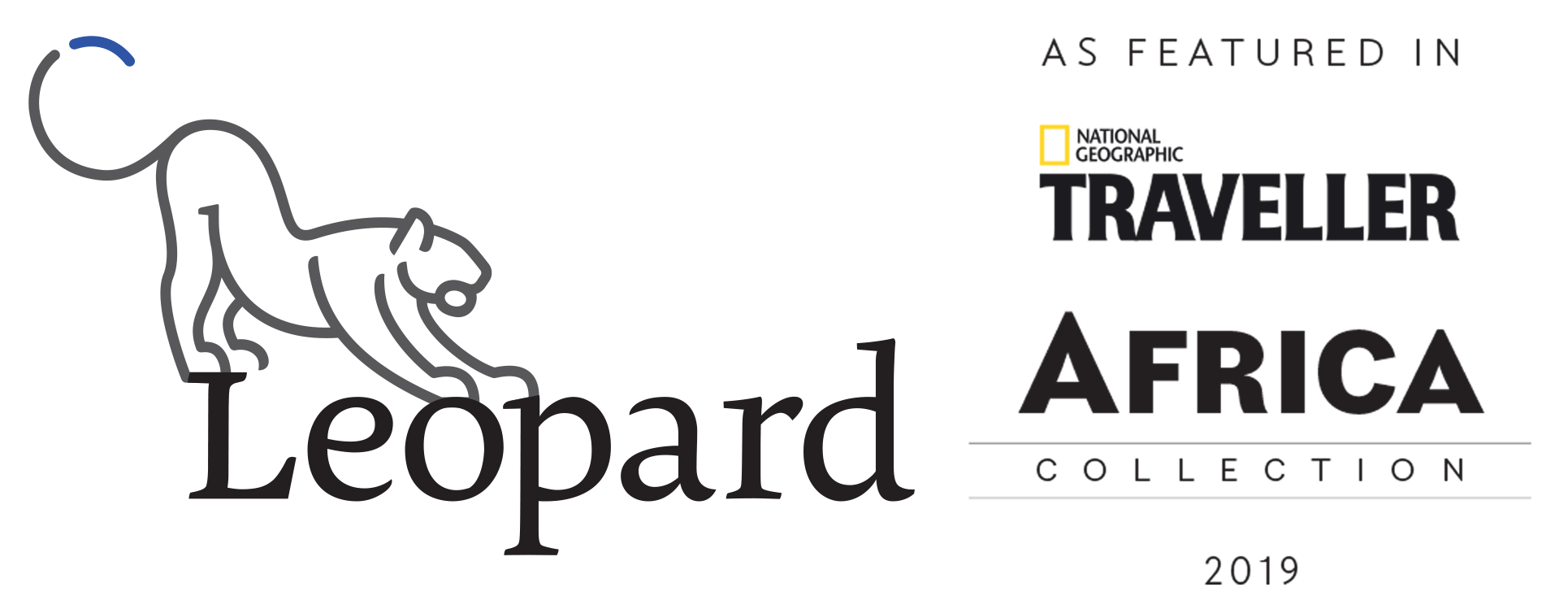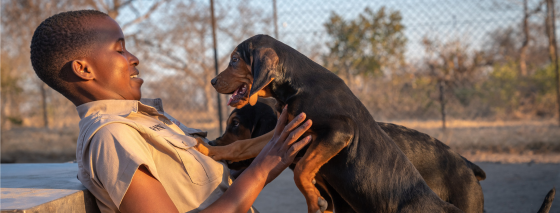Heroes of the Wild: Celebrating World Ranger Day with Inspiring Stories
World Ranger Day falls on 31 July each year, both honouring rangers who have been injured or killed in the line of duty and celebrating the ongoing efforts of rangers to protect Earth’s natural treasures. Below are some inspiring stories from four exceptional rangers who dedicate their lives to conservation. Diana has personally been guided by three, while the fourth, Precious Malapane works as both a ranger and a trainer at the K9 Unit of the Southern African Wildlife College, work supported by Leopard.
You’ll read about experiences as diverse as being part of The Ruaha Carnivore Project (RCP) to help protect lions and other wildlife in Tanzania to gorilla trekking in the rainforests of Rwanda, protecting lemurs in Madagascar, to working with dogs to track poachers in South Africa.

Hamza Visram: Head Guide and Guide Trainer, Elewana Collection, Tanzania
What is the best part of your job as a guide?
“Sharing my knowledge of the environment and its creatures with guests and guides.”
What is one challenge that you face as a guide?
“Making every guest happy because you encounter people with different interests.”
Do you have a positive conservation story you can share?
“In the Ruaha National Park in southern Tanzania, there are still very remote areas. One such place is Usangu Expedition Camp, on the edge of the wetlands, where I worked for a season.
This area was severely affected by poaching, particularly fishing in the Ruaha River and game meat poaching. The poaching drove animals away to the point that if they heard or saw a vehicle, they would run. We set up camera traps and managed to collar one lioness and three big male lions to track their movements and interactions. This conservation project was highly productive, helping us understand the lions’ movements and territory overlaps. We involved guests in setting up the camera traps, and at the end of their stay, we retrieved the photos together.
Previously, the source of the Ruaha River was being farmed for rice, which reduced the drinking water available for animals during the dry season. Now, it has been rewilded. If you visit, you’ll see herds of sable antelope, roan antelope, topi, and eland, in numbers similar to the migration in the Serengeti. It’s an amazing place.”
What is the funniest question a guest has asked you?
“I was once asked if elephants eat meat.”

Jean Marie Twambaze: Tour Guide, Rwanda
What is the best part of your job as a guide?
“I take travellers to different parks in Rwanda, such as Volcanoes, Akagera and Nyungwe National Parks. I love meeting people from different cultures, showing them the best of Rwanda and sharing my country’s conservation success stories. I love learning from people of different cultures too.”
Do you have a positive conservation story you can share?
“Yes, seeing the mountain gorilla population rise due to conservation efforts (by both the government and its partners) and seeing communities around parks developing and changing their mindset towards wildlife and parks. The communities’ involvement is just amazing.”
What is one challenge that you face as a guide?
“Guiding is fun but can be challenging sometimes. I try to set the correct expectations and this helps. However, I meet visitors who arrive with incorrect information and some of them are unwilling to adapt to have realistic expectations. Managing that situation can be challenging, but I always try to turn it into a positive experience.”
What is the funniest or strangest question a guest has asked you?
“Mountain gorilla babies are so cute and everyone would love to touch them, but of course this is not allowed. A traveller once asked if she could help a mother gorilla babysit her baby. That was both funny and strange.”

Herina Randrianarisoa: Guide in Ranomafana National Park, Madagascar
What is the best part of your job as a guide?
“My favourite part of guiding is sharing Madagascar’s rich fauna and flora with the world.”
Do you have a positive conservation story you can share?
“The forest (and its creatures) needs to be protected because there are many benefits to protecting it.” An example of this was that earlier this year, critically endangered greater bamboo lemurs were moved from Ivato to Ranomafana National Park, to help protect them and ensure their survival.
What is one challenge that you face as a ranger?
“The COVID-19 pandemic between 2020 and 2022 was the most challenging period for me.”
What is the funniest or strangest question a guest has asked you?
“A guest once asked, ‘Have you seen a lemur meeting before?”

Precious Malapane: K9 Unit Deployment Manager and Trainer, Southern African Wildlife College
What is the best part of your job as a ranger?
“Being the eyes and ears of nature and working with K9s to protect wildlife.
In the past, when we came across tracks of suspects, we had to follow them visually, which took much longer. Now, we can use the dogs to find suspects, sometimes before the end of the day. When we find suspects, we give them the run of their life. We chase them, and they drop their backpacks as they flee.
To explain further, first, the line dogs go with a ranger and follow the tracks. When we’re about an hour behind the suspect, we call in the helicopter with the pack dogs – up to six dogs can fit in the helicopter at a time. The pack dogs then run free and chase down the suspect while we keep an eye on them from the helicopter. It’s a Big 5 game area, and by keeping the helicopter close, we can deter other animals from interfering with the dogs. When the dogs catch up to the suspect, we land, take charge of the situation, and make the arrest.”
Do you have a positive conservation story you can share?
“Using K9s has reduced violent confrontations with poachers, saving lives on both sides. A life cannot be bought, it’s something that God gives and once it’s taken you can’t get it back. Using the dogs has helped protect both the rangers and the suspects’ lives.”
What is one challenge that you face as a ranger?
“Facing gender biases and dangerous wildlife encounters are significant challenges. As a woman, some men make you feel like you don’t know what you’re doing. We need support from the male rangers. The only thing that makes us different is our body structure. We can do the same hours and cover the same kilometres without a problem.
Another challenge is that we do get charged by animals. I was with a training group and a dog and we were charged by a bull elephant. I managed to communicate with the elephant with body language, raising my hands and shouting. Thankfully, he moved on and fortunately no one was harmed in these incidents.”
What is the funniest or strangest moment you’ve experienced while working with the dogs?
“Training puppies can be funny. When you start training them at six months old, they speak a different language to us. But, when the dog understands what you want, it’s like a light switch coming on.”
The ranger and guides interviewed here are only a tiny representation of all those doing critical work to protect Africa’s incredible natural treasures. You can support rangers and conservation efforts in a number of ways: by visiting the areas, by donating, volunteering, or spreading the word.
Happy travelling,
The Leopard Team
P.S. We’d love to hear your thoughts on this newsletter. Share your feedback or questions with us!
P.S. When you travel with Leopard, a portion of your travel spend directly supports the K9 Dog Unit’s vital work. However, regardless of your travel destination in Africa, your visit helps support local economies and, when visiting conservation areas, the wildlife too.
Sign up for more newsletters like this here: https://mailchi.mp/2e4afa50d15f/leopard


